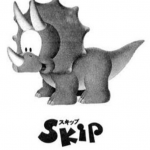JPO decision highlights (Similarity) [from January to June of 2022]
1 . Case in which the similarity of a word in singular form and the same word in plural form is discussed (1)
| Appeal No. | Present Trademark | Cited Trademark |
| 2021-3833 |  |
|
| Summary of Decision: The trademark of the present application “SKIPS” and Cited Trademark 1 “SKiP/スキップ (skip in Japanese KATAKANA characters) / figure of a dinosaur ” have a common concept. However, they can be clearly distinguished in appearance. In addition, it is possible to distinguish clearly by pronunciation. Therefore, it is appropriate to determine that the two trademarks are dissimilar trademarks when considered as a whole. * In the decision, it was determined that the Trademark of the Application and Cited Trademark 1 have a common concept of “jumping lightly, skipping.” In addition, in the decision, it was determined that the sound of “S” at the end of the term “SKIPS” makes a big difference between “SKIPS” (the present application) and “Skip” (Cited Trademark 1), because they have short pronunciations composed of only three- and four-sounds respectively. |
||
Comment
- When comparing two trademarks having only a few sounds, one small difference in their sounds makes the two dissimilar.
- The two trademark might have been decided as similar, if there was not figure of a dinosaur. Please see the next case.
2 . Case in which the similarity of a word in singular form and the same word in plural form is discussed (2)
| Appeal No. | Present Trademark | Cited Trademark |
| 2020-9057 | ||
| Summary of Decision: When comparing the present trademark “NEIGHBORS” and the cited trademark “ネイバー” (Neighbor), although they differ in appearance with the use of English and Katakana characters, both are commonly represented using interchangeable character types in trademark usage. Furthermore, comparing the pronunciation of the present and cited trademarks, both share the sound of “Neighbor,” with the only difference being the presence or absence of the sound “ズ” at the end. As the end sound is relatively difficult to perceive, the distinct difference arising from the letter “S” in the present trademark does not have a substantial impact. Additionally, both trademarks evoke the concept of “neighbor,” further emphasizing their similarity. Therefore, considering the appearance, pronunciation, and concept, both trademarks should be regarded as similar that may be easily confused with each other. |
||
Comment
- In Case 1, the two trademarks of “SKIPS” and “Skip + figurative element”, the only difference of which being the presence or absence of “S”at the end of the word part, are decided as dissimilar.
- On the contrary,“NEIGHBORS” and “ネイバー” (Neighbor) are decided as similar to each other in Case 2.
- These cases imply that the difference being the presence or absence of “S” in the end of the word is not enough to make the two marks dissimilar. Another element is required to differentiate the two, like a figurative element.
3 . Case in which the similarity of same words in different letter cases is discussed
| Appeal No. | Present Trademark | Cited Trademark |
| 2020-8314 | |
|
| Summary of Decision: The Trademark of the present application and the Cited Trademark share the common pronunciation of “ruby cell.” In terms of appearance, the trademark in the present application and the Cited Trademark have the same spelling, although there are differences in the presence or absence of a hyphen (-) and differences in uppercase and lowercase letters. Therefore, the trademark in the present application and the cited trademark give an impression of being similar to each other, so they should be regarded as similar trademarks that are likely to be confused with each other. |
||
Comment
- Two marks are regarded as similar to each other if letter cases is the only substantial difference.













